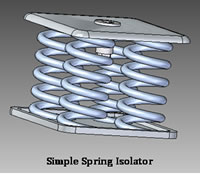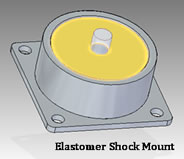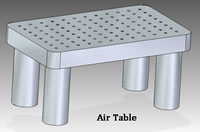Passive Vibration Isolation
As it relates to vibration isolation table, platform and
bench top systems developed by Minus K Technology
Vibrations can be isolated from equipment using active or
passive technology. With active methods, equal but opposite
forces are created electronically using sensors and actuators
to cancel out the unwanted vibrations. With passive methods,
isolation is achieved by limiting the ability of vibrations
to be coupled to the item to be isolated. This is done using
a mechanical connection which dissipates or redirects the
energy of vibration before it gets to the item to be isolated.
Passive methods sometimes involve electromechanical controls
for adjusting the system, but the isolation mechanism itself
is passive. Passive systems may use elastomers, springs, fluids,
or negative-stiffness components. Passive systems generally
cost less than active systems and their relative simplicity
makes them more reliable and safe.
 One of the most basic passive isolators is a spring
placed between the surface transmitting shock or vibration
and the item to be isolated. The spring opposes the impulse
on it and absorbs some energy as it deforms. A fluid or
elastomeric element is added to the spring element for
damping. A simple example is the shock absorber in a car.
In this case, mechanical energy from the shock or vibration
does work on the fluid and is converted to thermal energy
in the fluid, reducing the amount of energy transmitted
to the body of the car.
One of the most basic passive isolators is a spring
placed between the surface transmitting shock or vibration
and the item to be isolated. The spring opposes the impulse
on it and absorbs some energy as it deforms. A fluid or
elastomeric element is added to the spring element for
damping. A simple example is the shock absorber in a car.
In this case, mechanical energy from the shock or vibration
does work on the fluid and is converted to thermal energy
in the fluid, reducing the amount of energy transmitted
to the body of the car.
 Elastomers are rubber-like materials which
absorb mechanical energy by deforming. Examples of elastomeric
isolators are shock and vibration mounts for automobile
engines, aircraft components, industrial machinery, and
building foundations. Because rubber does not have the
same characteristics in all directions, isolation may
be much better in one axis than the others.
Elastomers are rubber-like materials which
absorb mechanical energy by deforming. Examples of elastomeric
isolators are shock and vibration mounts for automobile
engines, aircraft components, industrial machinery, and
building foundations. Because rubber does not have the
same characteristics in all directions, isolation may
be much better in one axis than the others.
The most sophisticated passive isolators use air or negative-stiffness
technology. In advanced technology applications, such as interferometry,
microscopy (including SPM, SEM, etc.), nano-fabrication and
micro-hardness testing, the best passive vibration isolation
devices allow the instruments to perform at their highest possible
level.
 Pneumatic systems support a heavy table
or platform on compressed air pistons, which provide the
decoupling link between the ground and the table, i.e.
the table floats on the air. The most sophisticated air
tables do a good job of isolating floor vibrations at
small amplitudes, but can be quite expensive. While they
isolate in a passive manner, they require an air supply,
a leveling system, and associated maintenance and controls.
The less sophisticated air systems do not isolate well
in all directions or at the low frequencies which are
handled so well by negative-stiffness systems. The air
supply system for pneumatic isolators can create problematic
ambient vibration. The use of electrical methods of leveling
the table and controlling air cylinder pressure adds complexity
and the potential for failure.
Pneumatic systems support a heavy table
or platform on compressed air pistons, which provide the
decoupling link between the ground and the table, i.e.
the table floats on the air. The most sophisticated air
tables do a good job of isolating floor vibrations at
small amplitudes, but can be quite expensive. While they
isolate in a passive manner, they require an air supply,
a leveling system, and associated maintenance and controls.
The less sophisticated air systems do not isolate well
in all directions or at the low frequencies which are
handled so well by negative-stiffness systems. The air
supply system for pneumatic isolators can create problematic
ambient vibration. The use of electrical methods of leveling
the table and controlling air cylinder pressure adds complexity
and the potential for failure.
 Negative-stiffness isolators provide a simple, reliable,
and highly effective isolation solution for sensitive
instrumentation at the low frequencies and amplitudes
of floor and building vibrations. They are relatively
small, light weight, stable, and cost-effective. Minus
K negative-stiffness isolators are completely mechanical;
for special applications, an optional electronic auto-adjust
system is available. Isolation is achieved using an arrangement
of springs and negative-stiffness mechanisms. These systems
provide isolation in 6 degrees of freedom with resonant
frequencies as low as 0.5 Hz or lower. For a 0.5-Hz system,
isolation begins around 1 Hz and is 50-100 times better
than most high-performance air tables in the 5-10 Hz range
which is so important in buildings. Multiple isolators
can be used together while still acting as one with respect
to vibration, which allows great versatility in designing
for a range of applications. Minus K's negative-stiffness
technology has been successfully implemented for sensitive
instrumentation loads from a few pounds to many tons.
The isolators are easy to use and adjust. They can be
more economical than air systems, take up less space,
provide better isolation at very low vibration amplitudes,
and require no maintenance.
Negative-stiffness isolators provide a simple, reliable,
and highly effective isolation solution for sensitive
instrumentation at the low frequencies and amplitudes
of floor and building vibrations. They are relatively
small, light weight, stable, and cost-effective. Minus
K negative-stiffness isolators are completely mechanical;
for special applications, an optional electronic auto-adjust
system is available. Isolation is achieved using an arrangement
of springs and negative-stiffness mechanisms. These systems
provide isolation in 6 degrees of freedom with resonant
frequencies as low as 0.5 Hz or lower. For a 0.5-Hz system,
isolation begins around 1 Hz and is 50-100 times better
than most high-performance air tables in the 5-10 Hz range
which is so important in buildings. Multiple isolators
can be used together while still acting as one with respect
to vibration, which allows great versatility in designing
for a range of applications. Minus K's negative-stiffness
technology has been successfully implemented for sensitive
instrumentation loads from a few pounds to many tons.
The isolators are easy to use and adjust. They can be
more economical than air systems, take up less space,
provide better isolation at very low vibration amplitudes,
and require no maintenance.
Negative-stiffness systems are typically not designed to handle large angular changes and shock loads such as occur in vehicle or aircraft applications. However, the Minus K devices can be used selectively to greatly enhance the performance of sensitive instruments during operations in vehicles or aircraft. Both pneumatic and negative-stiffness systems can be sensitive to temperature change but can be adjusted to compensate. Negative-stiffness systems can easily be used in a vacuum chamber or clean room, while air systems are prone to difficulties in this environment.
In addition to the standard products, Minus K designs custom
systems for special applications.